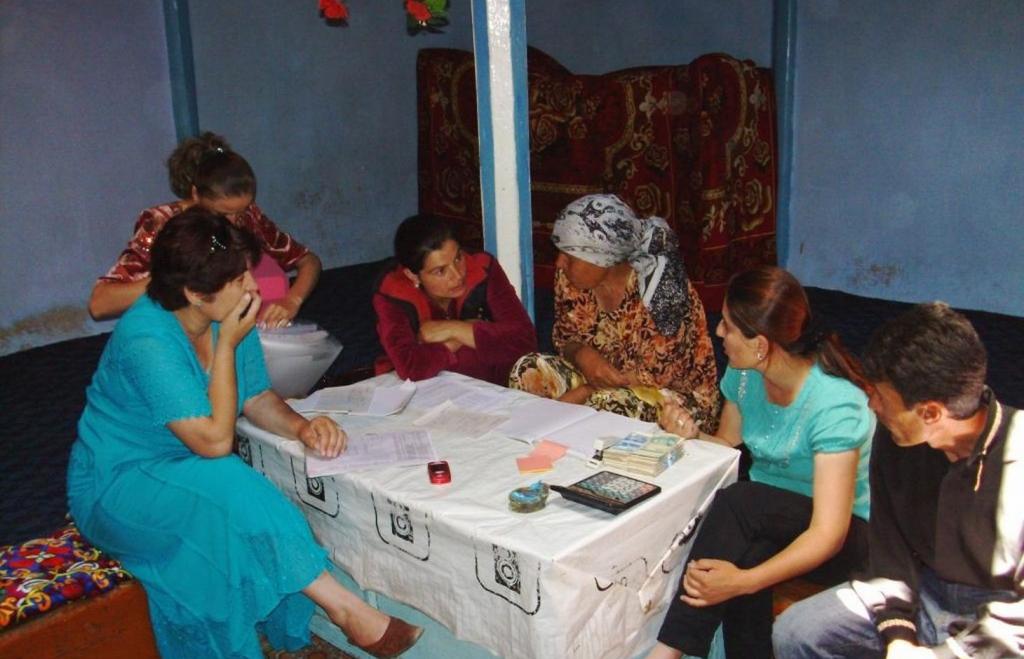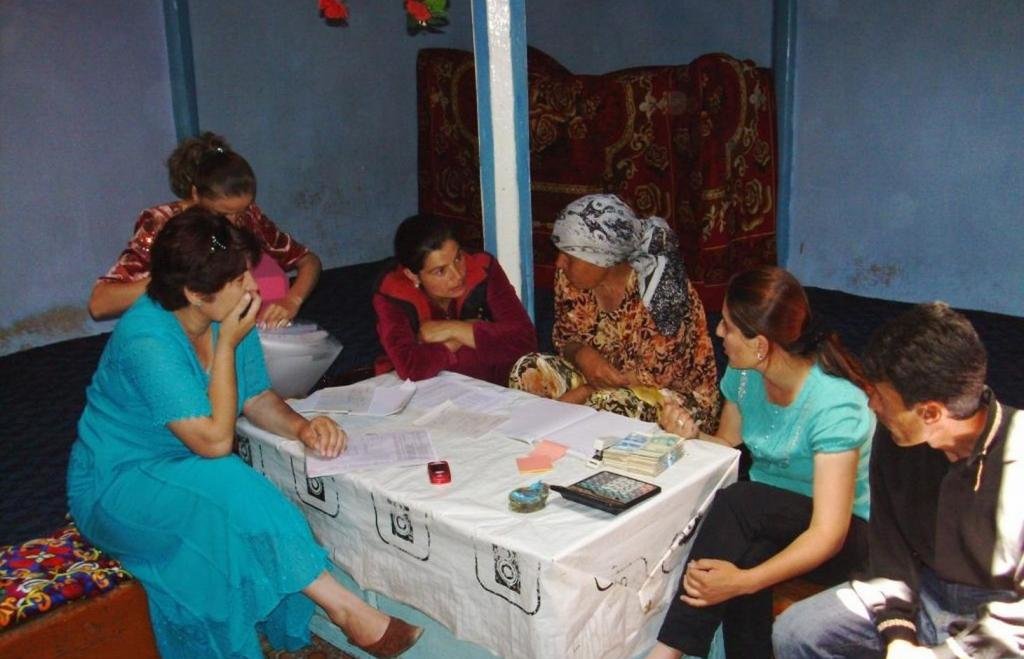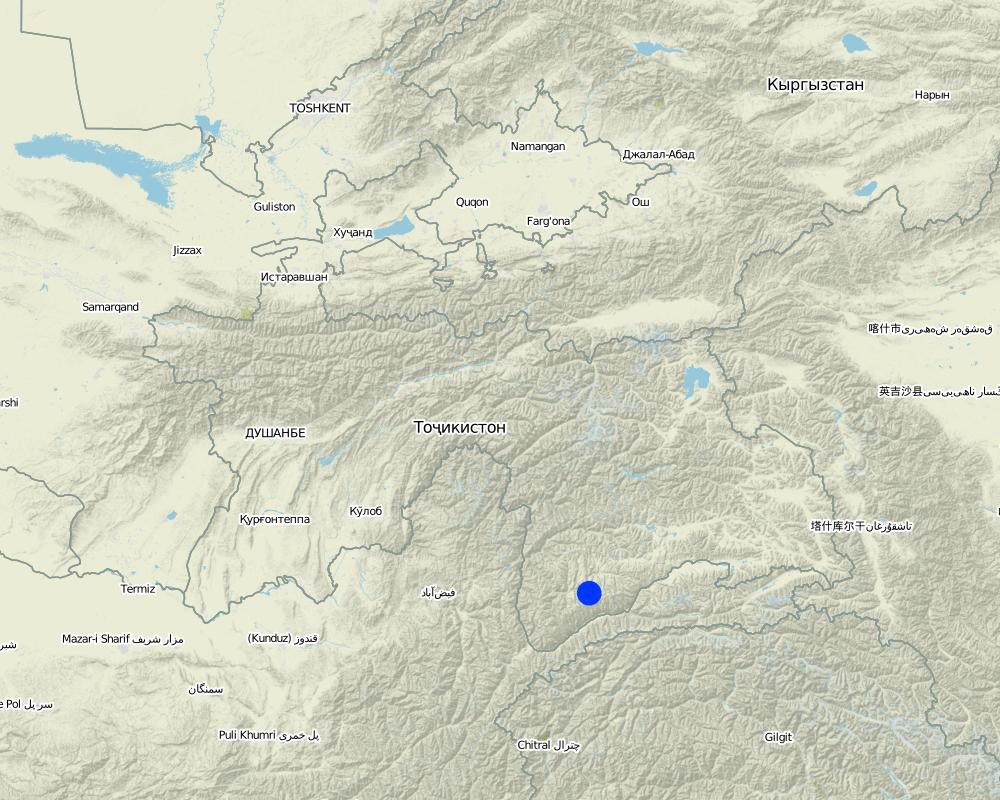Access to thermal insulation through micro loans [Tajikistan]
- Creation:
- Update:
- Compiler: Roziya Kirgizbekova
- Editor: –
- Reviewer: David Streiff
Tajikistan - Central Asian Countries Initiative for Land Management (CACILM/ИСЦАУЗР)
approaches_2575 - Tajikistan
View sections
Expand all Collapse all1. General information
1.2 Contact details of resource persons and institutions involved in the assessment and documentation of the Approach
Name of the institution(s) which facilitated the documentation/ evaluation of the Approach (if relevant)
Central Asian Countries Initiative for Sustainable Land Management - Multicountry Capacity Building (CACILM - MCB) - Kyrgyzstan1.3 Conditions regarding the use of data documented through WOCAT
When were the data compiled (in the field)?
2010
The compiler and key resource person(s) accept the conditions regarding the use of data documented through WOCAT:
Ja
1.4 Reference(s) to Questionnaire(s) on SLM Technologies
2. Description of the SLM Approach
2.1 Short description of the Approach
Provision of small scale loans for private households to ensure access to thermal insulation (in the frame of CACILM).
2.2 Detailed description of the Approach
Detailed description of the Approach:
Aims / objectives: In GBAO as in most parts of Tajikistan, natural resources such as firewood from riparian forests and teresken shrubs, remain the main source of fuel for heating and cooking. Due to poor insulation of local houses, and inefficient cooking stoves, much fuel is burned. The aim is to ensure access to energy efficient technologies through the provision of a micro loan 'Warm comfort' is one of the ways to improve house thermal insulation, reduce fire wood consumption, improve the living standards of residents and reduce pressure on the environment.
Methods: On the basis of financial and technical documentation prepared by field officers and clients MLO Madina made the decision to allocate up to US$500, (2.5% interest rate to be reimbursed within 12 months) to the project. The thermal insulation loan is given in kind and not in cash. The client receives all necessary materials and services for the value it has to reimburse in accordance with the micro loan contract and individual repayment schedule.
Stages of implementation: The process of a micro loan for thermal insulation consists of the following steps: 1) Meeting with the rural population and interviews; 2) information event on energy efficient products and micro loan; 3) Financial analysis to explain micro loans, procedures, household income and expenses analysis; 4) Technical analysis of potential houses to specify types of material needed, type of work, prepare outline of the house; 5) Decision by the MLO Committee to allocate loan; 6) Micro loan contract and work plan; 7) Preparation of thermal insulation works; 8) Implementation of thermal insulation works; 9) Reimbursement of micro loan
Role of stakeholders: The role of each participating stakeholder is indispensable to ensure a smooth flow for the whole process. The funding organisation assists the micro loan organisation with increasing its portfolio and provide loans for thermal insulation. The micro loan organisation develops the micro loan product for thermal insulation, it is responsible for monitoring and it is also part of the committee, which decides to allocate loans. Micro loan field officers in the villages provide financial information on households, which serves as basis for the committee to make the decision. They also regularly monitor the loan reimbursement. Agreement is established with suppliers of quality doors and windows, as well as suppliers of insulation materials such as cement, reflective foil, etc. to have a stable supply of required products. Qualified construction workers trained on thermal insulation install quality doors and windows, improve insulation of existing doors, windows, floors and ceilings. Recipients of the micro loan must show a willingness and an ability to repay the loan.
Other important information: Apart from thermal insulation measures, the micro loan is also available for other energy efficiency products such as: ram pumps, swimming pumps, rain water catchment systems, drip irrigation systems, winter heating and cooking stoves, summer cooking stoves.
2.3 Photos of the Approach
2.5 Country/ region/ locations where the Approach has been applied
Country:
Tajikistan
Region/ State/ Province:
Tajikistan/Gorno-Badakhshan Autonomous oblast
Further specification of location:
Roshtkala
Map
×2.6 Dates of initiation and termination of the Approach
Indicate year of initiation:
2009
Comments:
This approach is implemented in Shugnan, Murgab rayons, and also in Ishkashim
2.7 Type of Approach
- project/ programme based
2.8 Main aims/ objectives of the Approach
The Approach focused mainly on other activities than SLM (Micro loan, thermal insulation)
The aim is to ensure easier access to micro loans in order to make it more affordable for the local households to improve their house thermal insulation, and thus reduce fire wood consumption, mitigate health risks, improve general well being and in the longer term, reduce pressure on the environment.
The SLM Approach addressed the following problems: Use of large amounts of firewood/teresken, thus depleting natural resources, to provide heat due to poor house insulation. Lack of sufficient finances to improve house insulation.
2.9 Conditions enabling or hindering implementation of the Technology/ Technologies applied under the Approach
availability/ access to financial resources and services
- hindering
Households do not have enough financial resources available to buy afford thermal insulation for their houses.
Treatment through the SLM Approach: Offer micro loans with a low interest rate to be repaid within 12 months
legal framework (land tenure, land and water use rights)
- enabling
- hindering
knowledge about SLM, access to technical support
- hindering
Lack of technical knowledge on thermal insulation techniques
Treatment through the SLM Approach: Technical support, recommendations and conducting thermal insulation
workload, availability of manpower
- hindering
Households spend a large amount of time on collecting fuel resources to burn for heating and cooking
Treatment through the SLM Approach: Less workload due to reduced required amount of fuel
other
- hindering
Lack of knowledge about the correlation between poor insulation and fuel consumption.
Treatment through the SLM Approach: Awareness raising about positive effects of thermal insulation and product promotion
3. Participation and roles of stakeholders involved
3.1 Stakeholders involved in the Approach and their roles
- local land users/ local communities
Households who took out a loan for thermal insulation
Households which cannot afford thermal insulation costs in one go, as it is a big financial burden for them, make use of the micro loan. Especially, female-headed households that have very little income.
- SLM specialists/ agricultural advisers
Thermal insulation advisers
- NGO
MLO 'Madina'
Approach was developed jointly by local MLO Madina and GIZ Project 'Sustainable Management of Natural Resources in GBAO' in order to suit thermal insulation
- international organization
Deutsche Gesellschaft für Internationale Zusammenarbeit (GIZ) GmbH
- Suppliers of doors, windows and construction materials, workers
3.2 Involvement of local land users/ local communities in the different phases of the Approach
| Involvement of local land users/ local communities | Specify who was involved and describe activities | |
|---|---|---|
| initiation/ motivation | interactive | Household members take part in public meetings and awareness raising workshops |
| planning | interactive | Household members jointly with technical and financial specialists prepare a work plan for implementing the insulation works |
| implementation | passive | |
| monitoring/ evaluation | interactive | The users and specialists assess the efficiency of the micro loan and its procedures |
| Research | none |
3.4 Decision-making on the selection of SLM Technology/ Technologies
Specify who decided on the selection of the Technology/ Technologies to be implemented:
- SLM specialists alone
Explain:
Decisions on the method of implementing the SLM Technology were made by by SLM specialists alone (top-down)
4. Technical support, capacity building, and knowledge management
4.1 Capacity building/ training
Was training provided to land users/ other stakeholders?
Ja
Specify who was trained:
- land users
- field staff/ advisers
- Craftsmen
Form of training:
- demonstration areas
- public meetings
- courses
Subjects covered:
Awareness raising among the local population on the reasons for, and the effects of bad insulation of houses. The advantages and disadvantages of thermal insulation. Information on existing funding opportunities for thermal insulation. Training of local craftsmen on thermal insulation technologies, and the production of quality and well-insulated doors and windows.
4.2 Advisory service
Do land users have access to an advisory service?
Nee
4.3 Institution strengthening (organizational development)
Have institutions been established or strengthened through the Approach?
- no
4.4 Monitoring and evaluation
Is monitoring and evaluation part of the Approach?
Ja
Comments:
no. of land users involved aspects were regular monitored by project staff through measurements; indicators: None
economic / production aspects were ad hoc monitored by project staff through measurements; indicators: None
economic / production aspects were regular monitored by land users through observations; indicators: None
technical aspects were regular monitored by project staff through measurements; indicators: None
technical aspects were regular monitored by land users through observations; indicators: None
management of Approach aspects were None monitored by project staff through measurements; indicators: None
There were few changes in the Approach as a result of monitoring and evaluation: Initially the micro loan was provided in cash directly to the households, but the results of monitoring showed that not the full amount of the loan was used for thermal insulation purposes. Therefore the MLO decided to allocate the loan for thermal insulation in kind; in the form of products and services, which proved to be more efficient.
There were few changes in the Technology as a result of monitoring and evaluation: Following ongoing discussions with craftsman and construction workers a follow-up seminar was conducted, where problems and possible changes were discussed in order to improve the quality of thermal insulation products. E.g. the roof hatch window had an opening, but it was not possible to open it from inside the room. As consequence every subsequent roof hatch window will have a lever connected to a string in order to open the window more easily.
4.5 Research
Was research part of the Approach?
Nee
5. Financing and external material support
5.1 Annual budget for the SLM component of the Approach
If precise annual budget is not known, indicate range:
- 2,000-10,000
Comments (e.g. main sources of funding/ major donors):
Approach costs were met by the following donors: local community / land user(s) (Micro loan borrower pays for insulation materials, construction, installation): 90.0%; private sector (MLO Madina offers technical and financial consultancy free of charge): 1.5%; international (GIZ grant for allocating micro loans ): 3.5%; other (Transportation ): 5.0%
5.2 Financial/ material support provided to land users
Did land users receive financial/ material support for implementing the Technology/ Technologies?
Nee
5.3 Subsidies for specific inputs (including labour)
- construction
| Specify which inputs were subsidised | To which extent | Specify subsidies |
|---|---|---|
| doors, windows, insulation materials | repayable loans. | |
Comments:
The micro loan fully covers the costs for purchasing doors, windows and insulation material as well as the installation. The transportation costs for delivering the products is paid separately in cash by the client.
5.4 Credit
Was credit provided under the Approach for SLM activities?
Ja
Specify conditions (interest rate, payback, etc.):
Interest rate charged: 30.0%; repayment conditions: Repayment should be completed within 12 months, with 1 month grace period allowed. This equates to a 2.5% interest rate per month..
Interest was lower than market rate.
Specify credit receivers:
Individual households receive credit to implement house thermal insulation
5.5 Other incentives or instruments
Were other incentives or instruments used to promote implementation of SLM Technologies?
Nee
6. Impact analysis and concluding statements
6.1 Impacts of the Approach
Did the Approach help land users to implement and maintain SLM Technologies?
- No
- Yes, little
- Yes, moderately
- Yes, greatly
Micro loans were given so people could afford to thermally insulate their houses, which reduces fire wood consumption and thus contributes to the preservation and improvement of natural vegetation.
Did the Approach empower socially and economically disadvantaged groups?
- No
- Yes, little
- Yes, moderately
- Yes, greatly
Households save time and money on fuel, and can use this money for other purposes.
Did other land users / projects adopt the Approach?
- No
- Yes, little
- Yes, moderately
- Yes, greatly
Following MLO Madina, other MLOs in Tajikistan started to include “Micro loans for thermal insulation” into their portfolio. One is MLO Ishkashim in GBAO, a second one is MLO Haqiq in the Baljuvon District of the Khatlon Region.
Did the Approach lead to improved livelihoods / human well-being?
- No
- Yes, little
- Yes, moderately
- Yes, greatly
The household living conditions were improved as they now live in warmer and more comfortable houses with reduced health risks
Did the Approach help to alleviate poverty?
- No
- Yes, little
- Yes, moderately
- Yes, greatly
6.2 Main motivation of land users to implement SLM
- reduced workload
Less time is spent on collecting fire wood
- environmental consciousness
Fear to fully destroy the surrounding nature
- well-being and livelihoods improvement
Well-insulated houses allow households to save money and live more comfortably
6.3 Sustainability of Approach activities
Can the land users sustain what has been implemented through the Approach (without external support)?
- yes
If yes, describe how:
Sustainability is guaranteed by incentives along the value chain and introduced market mechanisms
6.4 Strengths/ advantages of the Approach
| Strengths/ advantages/ opportunities in the land user’s view |
|---|
| Improved knowledge on thermal insulation and micro loans |
| Access to thermal insulation |
| Reduced costs for fuel consumption |
| Strengths/ advantages/ opportunities in the compiler’s or other key resource person’s view |
|---|
| Less harm to the environment |
| There was control of the whole process to ensure efficiency |
| Improved living conditions |
| Financial source with low interest rate |
6.5 Weaknesses/ disadvantages of the Approach and ways of overcoming them
| Weaknesses/ disadvantages/ risks in the compiler’s or other key resource person’s view | How can they be overcome? |
|---|---|
| Some households still cannot afford the loan | Search for donor funding to establish a separate loan for the most poor |
| Whether MLO can sustain the interest rates without support coming from grants | The interests rates are still high, there could be a reduction in interest rate or the further payment holidays. |
| Costs for training and awareness raising | Initial investments as MLO cannot finance these activities |
7. References and links
7.1 Methods/ sources of information
- field visits, field surveys
- interviews with land users
7.3 Links to relevant information which is available online
Title/ description:
Micro loans for thermal insulation: A product documentation based on the experience of Tajik Gorno Badakhshan, Andre Fabian, Heike Volkmer, Christoph Wiedemann, 2010
URL:
http://www.naturalresources-centralasia.org/assets/files/2010-09-15_product_documentation_thermal_insulation_FINAL_rus.pdf
Links and modules
Expand all Collapse allLinks
No links
Modules
No modules






